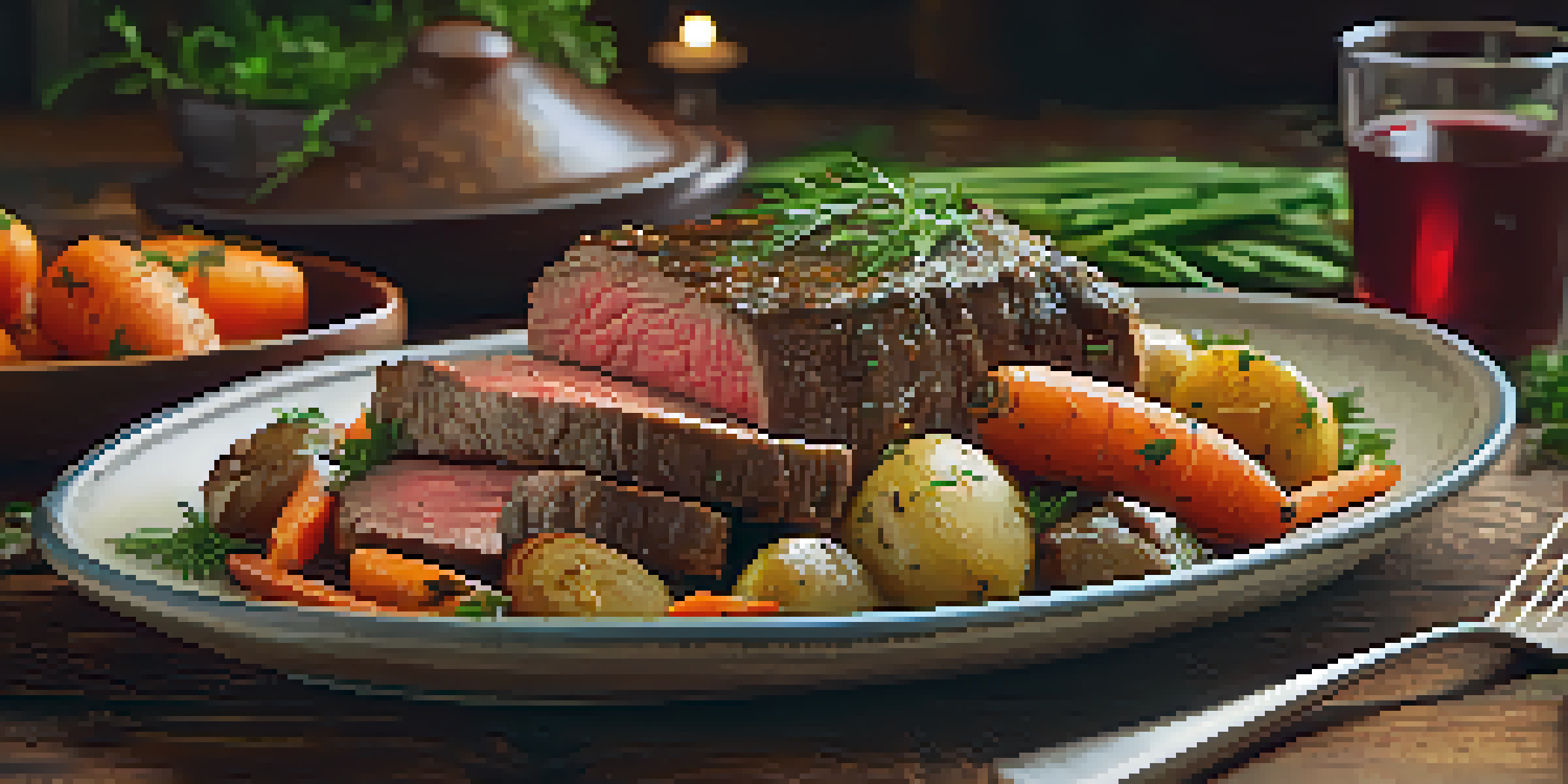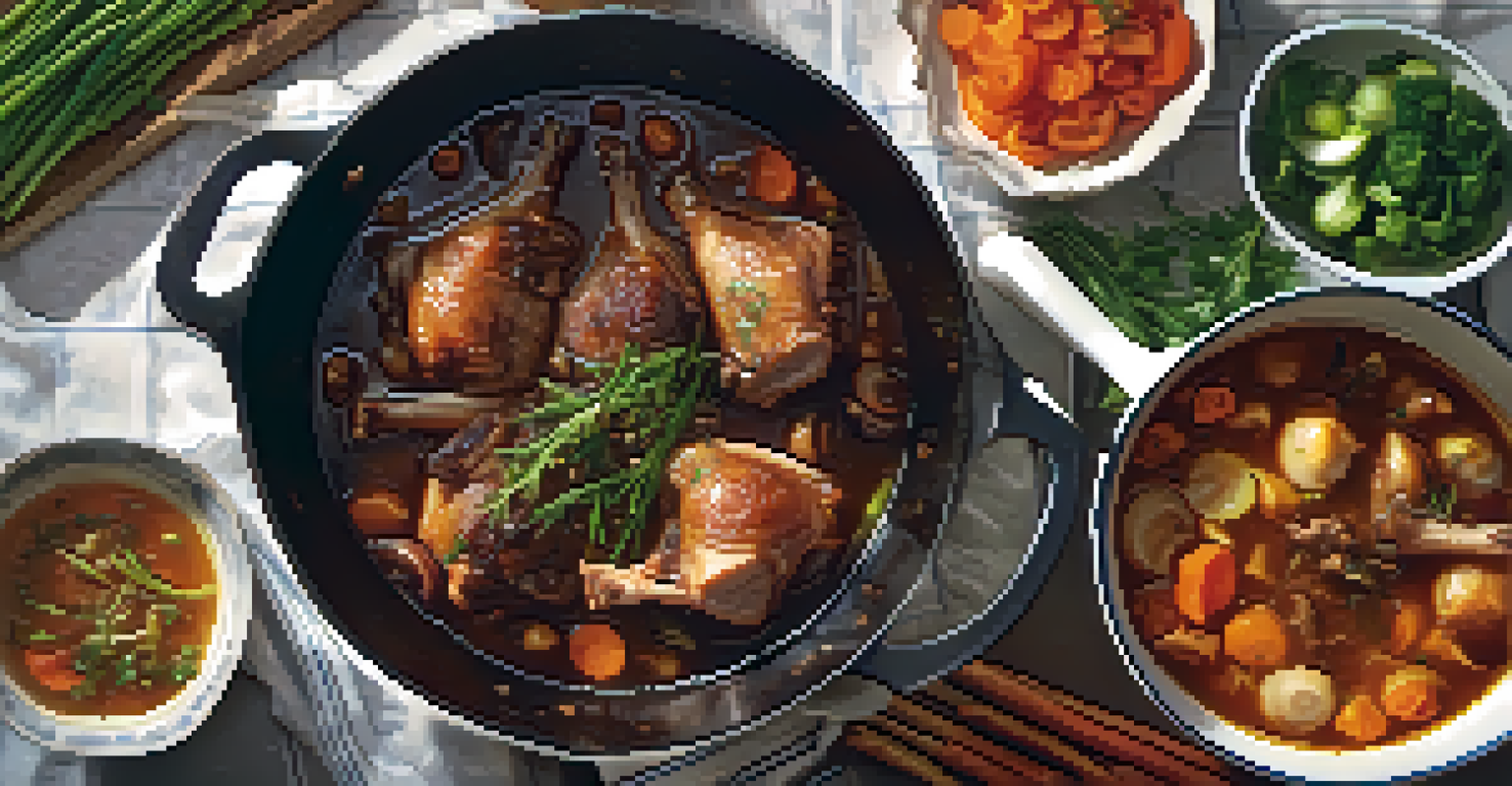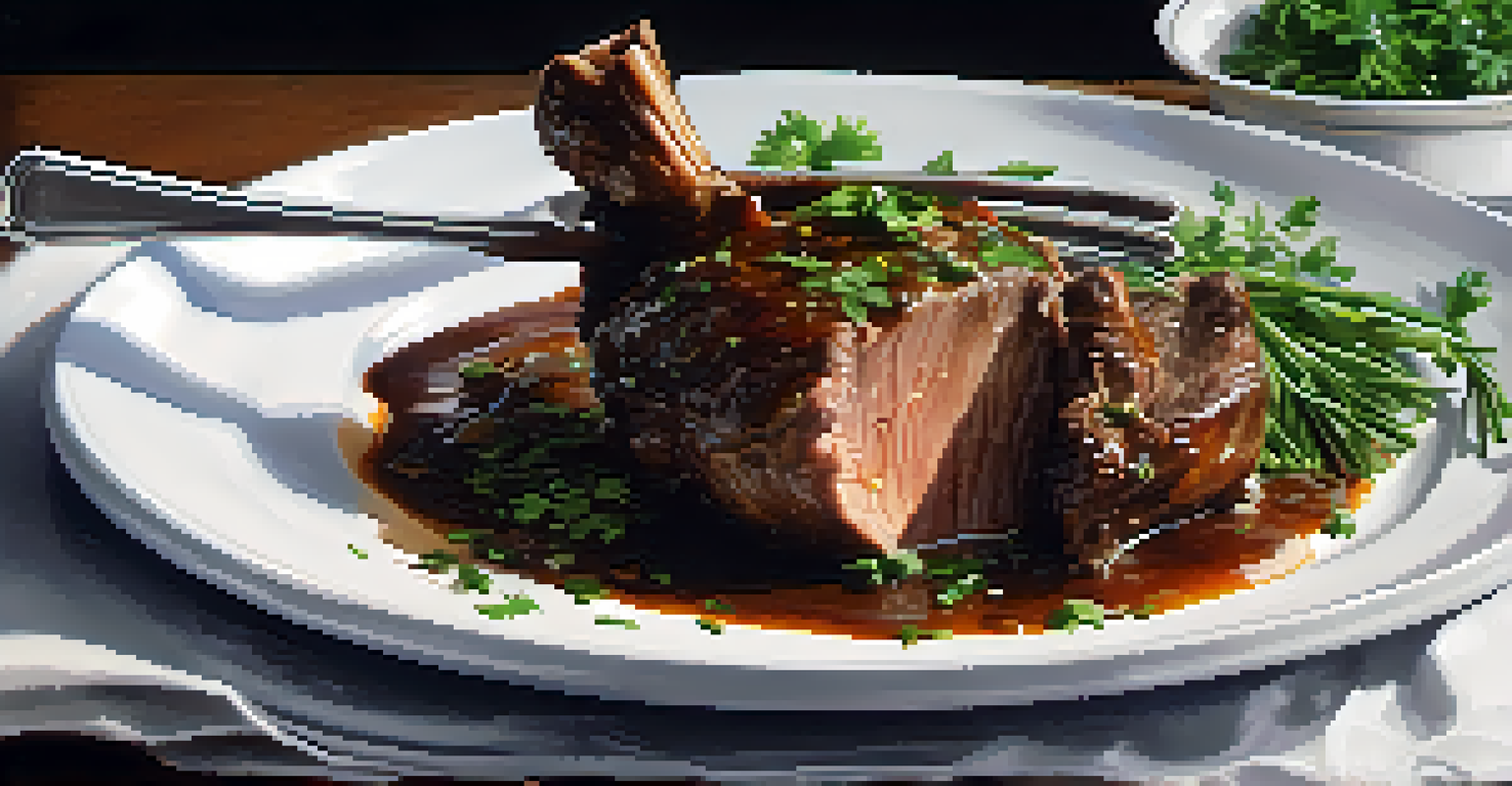Braising Basics: Techniques for Tender and Flavorful Meats

Understanding the Art of Braising: What Is It?
Braising is a cooking method that combines both dry and wet heat to transform tough cuts of meat into tender, flavorful dishes. It typically involves searing the meat first to develop a rich crust, followed by slow cooking in a covered pot with some liquid. This two-step process not only enhances the meat's texture but also allows it to absorb the flavors of the surrounding ingredients.
Cooking is like love. It should be entered into with abandon or not at all.
You can think of braising as a cozy hug for your meat; it’s all about creating a warm, flavorful environment where the meat can gently cook and soak up the goodness of its surroundings. Whether you're braising beef, pork, or even vegetables, the key is patience. The longer cooking time allows tougher cuts to break down and become melt-in-your-mouth tender.
So, if you’ve ever wondered how to turn a simple piece of meat into a gourmet meal, braising might just be your new best friend in the kitchen!
Choosing the Right Cut of Meat for Braising
Not all meats are created equal when it comes to braising. The best candidates are tougher cuts that come from well-exercised muscles, like chuck roast, brisket, or shanks. These cuts contain more connective tissue, which breaks down during the long cooking process, resulting in a tender texture and rich flavor.

Imagine trying to braise a delicate cut like filet mignon; it would be like trying to make a cozy blanket out of a handkerchief! Instead, opt for those hearty cuts that can withstand the heat and time. They not only become tender but also release their flavors, enriching the braising liquid.
Braising Makes Tough Meat Tender
This cooking method uses both dry and wet heat to transform tough cuts of meat into flavorful, melt-in-your-mouth dishes.
When shopping, keep an eye out for marbling—those little flecks of fat within the meat. They’ll melt during cooking, adding moisture and flavor, ensuring your final dish is anything but dry.
Essential Ingredients for a Flavorful Braise
A successful braise relies on a combination of quality ingredients. Aside from your meat, think aromatics like onions, garlic, and carrots, which add depth to the dish. Herbs and spices also play a crucial role; bay leaves, thyme, or even a splash of red wine can elevate the flavors to new heights.
The secret of success in the kitchen is to have a good recipe and the patience to follow it.
Consider the braising liquid as the soul of your dish. Whether it's broth, wine, or a combination, it should complement the meat and ingredients you’re using. For instance, braising lamb with a robust red wine can create a mouthwatering dish that’s perfect for a special occasion.
Don't be afraid to experiment! You can even add unexpected elements like citrus peels or dried fruits for a unique twist. The beauty of braising is that it allows for creativity while still delivering a comforting meal.
The Perfect Braising Technique: Step-by-Step
To achieve the perfect braise, start by seasoning your meat generously with salt and pepper. This not only enhances flavor but also helps create a nice crust during searing. Heat some oil in a heavy-bottomed pot and brown the meat on all sides. This initial step locks in flavors and adds a beautiful color.
Once your meat is browned, remove it from the pot and sauté your aromatics until they become fragrant and slightly softened. This is the moment to add your braising liquid, scraping up any flavorful bits stuck to the bottom of the pot—those are pure gold!
Choose the Right Cuts for Braising
Opt for tougher, well-exercised cuts like chuck roast or brisket, as they break down during cooking to enhance flavor and texture.
Return the meat to the pot, ensuring it's partially submerged in the liquid, cover it, and let it simmer on low heat. Whether you choose the stovetop or an oven, the key here is low and slow, allowing the flavors to meld and the meat to become fork-tender.
Choosing Between Stovetop and Oven Braising
When it comes to braising, you have two primary options: stovetop or oven. Stovetop braising offers more control over the heat, allowing for quick adjustments if needed. It’s also convenient for those who prefer to keep an eye on things as they cook.
On the other hand, oven braising provides an even heat distribution that can enhance the cooking process, especially for larger cuts of meat. The dry heat from the oven helps create a lovely crust while keeping the inside moist and tender.
Ultimately, the choice between the two methods may come down to personal preference or the specific recipe you’re following. Both will yield delicious results, so feel free to experiment and see which method you enjoy more!
Timing: How Long Should You Braise Your Meat?
Timing is crucial in braising, as different cuts of meat require varying lengths to become tender. Generally, tougher cuts need a longer cooking time—anywhere from two to four hours, depending on the size and type of meat. The goal is to break down the collagen and connective tissue, which transforms those cuts into tender delights.
A great tip is to check for doneness by using a fork; if it easily pulls apart, you know you’ve hit the sweet spot. If you’re unsure, it's better to give it a bit more time than to rush the process. Remember, patience is key in braising!
Timing is Key in Braising
Different cuts require varying cooking times, typically ranging from two to four hours, to achieve the perfect tenderness.
Additionally, you can always use a meat thermometer to ensure your meat reaches the desired internal temperature. Aim for around 190°F to 205°F for the perfect tender result.
Finishing Touches: Enhancing Your Braised Dish
Once your meat is perfectly braised, it’s time to elevate your dish with a few finishing touches. Start by removing the meat from the pot and letting it rest for a few minutes—this helps retain its juices. Meanwhile, you can strain the braising liquid, reducing it on the stovetop to create a rich sauce.
Consider adding a sprinkle of fresh herbs or a squeeze of citrus juice for brightness. This can really elevate the flavors and balance the richness of the meat. Think of it as adding a dash of personality to your dish!

Finally, when serving, don’t forget to spoon some of that luscious sauce over your meat. It’s the final flourish that ties everything together, making your braised dish not only delicious but also visually appealing.